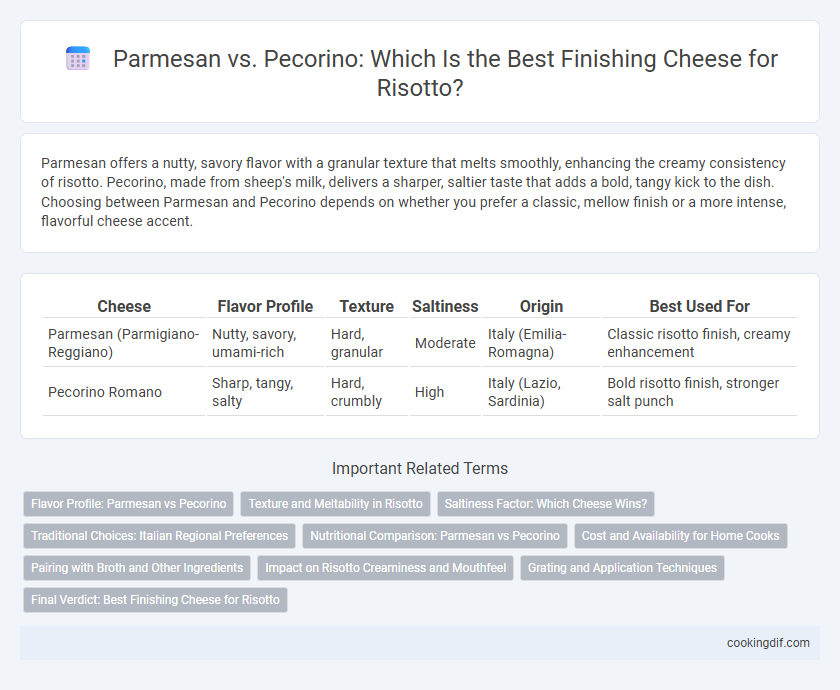Parmesan offers a nutty, savory flavor with a granular texture that melts smoothly, enhancing the creamy consistency of risotto. Pecorino, made from sheep's milk, delivers a sharper, saltier taste that adds a bold, tangy kick to the dish. Choosing between Parmesan and Pecorino depends on whether you prefer a classic, mellow finish or a more intense, flavorful cheese accent.
Table of Comparison
| Cheese | Flavor Profile | Texture | Saltiness | Origin | Best Used For |
|---|---|---|---|---|---|
| Parmesan (Parmigiano-Reggiano) | Nutty, savory, umami-rich | Hard, granular | Moderate | Italy (Emilia-Romagna) | Classic risotto finish, creamy enhancement |
| Pecorino Romano | Sharp, tangy, salty | Hard, crumbly | High | Italy (Lazio, Sardinia) | Bold risotto finish, stronger salt punch |
Flavor Profile: Parmesan vs Pecorino
Parmesan cheese offers a nutty, savory flavor with a slightly granular texture, perfect for enhancing risotto with subtle umami notes. Pecorino, made from sheep's milk, delivers a sharper, saltier, and more robust taste, giving risotto a bold and tangy finish. Choosing between Parmesan and Pecorino depends on whether a creamy, mellow depth or an intense, piquant flavor is desired for the dish.
Texture and Meltability in Risotto
Parmesan cheese offers a granular texture and superior meltability, creating a creamy, smooth finish that enhances the risotto's silkiness. Pecorino has a firmer, slightly crumbly texture with a sharper flavor, which can result in a more pronounced, less uniform melt throughout the dish. Choosing Parmesan emphasizes creaminess and uniform integration, while Pecorino adds a distinct texture contrast and robust flavor in the risotto's finish.
Saltiness Factor: Which Cheese Wins?
Parmesan, known for its balanced umami and mild saltiness, melts smoothly into risotto, enhancing without overpowering the dish. Pecorino, made from sheep's milk, delivers a sharper, saltier punch that intensifies the flavor profile but requires careful use to avoid overpowering the delicate creaminess of risotto. For those prioritizing a subtle saltiness to complement the rice's texture, Parmesan wins, while Pecorino suits risotto lovers seeking a bolder, saltier finish.
Traditional Choices: Italian Regional Preferences
In traditional Italian risotto recipes, Parmesan (Parmigiano-Reggiano) is favored in northern regions like Lombardy and Veneto, prized for its nutty, slightly sweet flavor and granular texture that melts smoothly into the creamy rice. Pecorino Romano, a sharper and saltier sheep's milk cheese, is preferred in central and southern Italy, adding a bold, tangy finish that complements heartier risotto dishes. Regional preferences highlight Parmesan's mild umami in delicate risottos versus Pecorino's robust character enhancing rustic, robust flavors.
Nutritional Comparison: Parmesan vs Pecorino
Parmesan cheese boasts higher protein content and lower fat compared to Pecorino, making it a leaner option for risotto finishing. Pecorino contains more calcium and sodium, contributing to a saltier, more robust flavor profile. Both cheeses deliver essential nutrients, but Parmesan's lower fat and higher protein make it preferable for health-conscious risotto preparations.
Cost and Availability for Home Cooks
Parmesan is often favored by home cooks for finishing risotto due to its widespread availability and moderate cost in most grocery stores. Pecorino, while offering a sharper and saltier flavor, tends to be pricier and less commonly stocked, making it a less accessible option for everyday use. Choosing Parmesan provides a balance of authentic taste and budget-friendly convenience, especially for home cooks seeking consistent results.
Pairing with Broth and Other Ingredients
Parmesan cheese offers a nutty, umami-rich flavor that perfectly complements chicken or vegetable broth, enhancing the creamy texture of risotto without overpowering delicate ingredients like mushrooms or asparagus. Pecorino, with its sharper, saltier profile, pairs well with robust broths such as beef or game stock and stands out in risottos featuring bold ingredients like sausage or aged cured meats. Choosing Parmesan or Pecorino as the finishing cheese depends on the broth base and main ingredients, balancing richness and savoriness for an optimal flavor harmony.
Impact on Risotto Creaminess and Mouthfeel
Parmesan enhances risotto with a rich, nutty flavor and contributes to a creamy, velvety texture due to its balanced fat and moisture content. Pecorino, being sharper and saltier, adds a more intense, tangy taste that can slightly alter the risotto's creaminess, resulting in a firmer mouthfeel. Choosing Parmesan typically delivers a smoother, more luxurious risotto experience, while Pecorino introduces a pronounced flavor profile with a subtly denser consistency.
Grating and Application Techniques
Parmesan offers a fine, granular texture that melts smoothly into risotto, enhancing creaminess without overpowering the dish, making it ideal for gradual incorporation during the final stages of cooking. Pecorino, with its sharper, saltier profile and coarser grate, is best sprinkled sparingly after plating, providing a distinct, bold flavor contrast that complements the risotto's richness. Both cheeses require dry grating to prevent clumping, but Parmesan's softer melt suits continuous stirring, while Pecorino's robust taste benefits from a fresh, sharp finish for optimal flavor impact.
Final Verdict: Best Finishing Cheese for Risotto
Parmesan provides a nutty, umami-rich flavor with a creamy texture that melts seamlessly into risotto, enhancing its traditional profile. Pecorino, offering a sharper and saltier taste from sheep's milk, adds a distinct boldness but can overpower delicate flavors. Parmesan remains the best finishing cheese for risotto, balancing flavor complexity and smooth integration perfect for the dish's creamy consistency.
Parmesan vs Pecorino for finishing cheese Infographic

 cookingdif.com
cookingdif.com